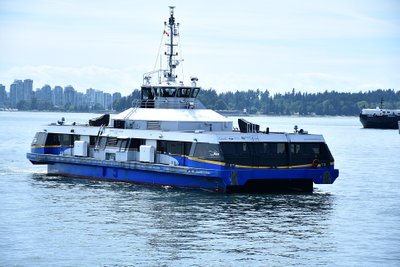The tragedy of the Santa Cruz ferry
The emotion of the passengers left no doubt about the joy of that journey. It was the most important vacation period of the year. The tickets had been sold out since July and the illusion of visiting Margarita Island was a dream for any Venezuelan.
The morning sky was clear. The swell was soft as the wind. The ferry was moving fast because of its powerful engines. Children ran and played between the tables in the large main hall.
Several people went out on the outdoor deck to enjoy the sea breeze and the sun while the iron body sailed on the deep waters. It was a great pleasure to watch the immense sea from the bow of the ship.
The ferry had no cabins because it was designed for short trips. In the cockpit at the top of the ferry were the captain and two assistants.
The men in the crew were responsible for the engine room, the cleaning of the toilets, common areas and the safety of the passengers at sea.
An hour into the journey, the captain of the ship José Vásquez passed out for no apparent reason. The assistants who were with him lifted him from the carpeted floor and placed him on a chair.
The man never woke up. He only opened his eyes for a few seconds in desperation, took in air through his mouth as if he were short of breath and died.
The crew was warned of his death. Pedro Mata assumed the captainship of the ferry from that moment on.
He radioed the port on Margarita Island to tell them what had happened. They placed the captain's inert body in black bags and continued the voyage.
The whole event lasted barely half an hour. The mountains of the island were already visible on the horizon. But inexplicably there were ten other deaths among the passengers. They all presented the same symptoms: fainting, difficulty in breathing and almost immediate death. Six men and four women were the victims.
The crew and passengers were in a state of anguish. The report was passed on the radio to the port.
The bodies were moved to a small room and the passengers were placed on the open deck and the large main room.
A short distance from the port the ferry machine slowed down and started maneuvering to drop the anchors. The new captain received a warning that they should stop. A doctor, a nurse and a forensic doctor would come on board to check the bodies and the rest of the passengers.
The engines were shut down. The ferry was left drifting but was already in the bay area. A small boat arrived with health personnel who boarded the ship.
Five hours later another 30 people had died. The screaming was deafening and hellish. From the mainland they did not let anyone off the ferry, not even the doctors and nurses who had gone to make the inspection.
The boat was declared in emergency and in isolation.
Floats were placed around the ferry and men who had jumped into the water to swim to the nearest shore were forced to get on the ferry again.
No one was allowed to enter or leave the ship of death.
There was a virus in the air that was killing those humans. They knew they had no salvation. Those with family ties gathered in small groups. When someone collapsed was moved to the small room; whether were dead or alive.
At six o'clock in the evening, the lights were turned on in the ferry. Also, in the distant boats that guarded the Santa Cruz ferry, the lights were turned on and directed towards the waterline of the sentenced boat. Panic was on board.
A woman placed an 8-month-old child in a wicker basket discreetly under a table. She, his mother, moved away from the place and died.
Men and women were still trying to get off the ferry by throwing themselves into the sea but it was no use. The ferry was surrounded and those who did not obey the order to return to the ship were warned with bullets. A man was wounded in one hand. He shouted, cowards! from the water to his attackers but he returned to the ferry.
Only 24 hours after the Santa Cruz ferry left the port of La Guaira 235 passengers had already died. Also all the crew and the staff for the sanitary inspection.
The resignation was palpable.
At 10 a.m. from a coast guard boat they spoke through a megaphone asking if anyone was alive. Some people signaled with their arms from the deck. Then they were warned that they had to stay there until they found a vaccine to administer and protect the rest of the population.
At 2 o'clock in the afternoon, from the same boat, they asked if anyone was alive. There was no sign. At 6 p.m., the lights on the guardian boats were turned on, but the lights were not turned on from inside the ferry.
At 6 a.m., the coast guard boat sailed around the ferry. They asked several times if anyone was alive. There was no answer.
The same process occurred at 12 noon. There was no answer either.
At 2 p.m. two men were in charge of boarding the ferry and burning all the bodies. It was devastating for the mariners, the landscape of death they saw. They piled the bodies one by one in different places, sprayed kerosene on them and set them on fire.
In the little room where the first dead were, there were even worms caming out below the door. The smell was nauseating. Kerosene was more abundant there.
The task had to be done quickly. And so it was until the crying of a baby paralyzed them. They looked for where the sound was coming from and found a baby wrapped in blankets under a table. The two men looked into each other's eyes through the masks of their special clothes.
Next to the wicker basket was a bag of baby food. They had to make a hasty decision. And so they did!
They quickly made a bottle and gave it to baby to drink. The crying stopped. They loaded the basket towards the deck and finished stacking and burning the last bodies.
One of the men put the baby in his special clothes and left the ferry with his secret.
Only they knew that the kid was the only survivor of the plague that hit the Santa Cruz ferry. They could never explain what saved him. He was baptized with the name Cruz José and grew up healthy and strong.
That baby is today a seaman. He is living proof of a miracle or of a new generation that is immune to a virus that is still unknown where it came from.



Thanks for reading.
Welcome your comments
Infinite greetings!



© Jul 2020, Marcy Betancourt. All rights reserved

This is a riveting story, @marcybetancourt. I can see why you had to tell it from an omniscient point of view, because there are no survivors except the baby who could tell the story. I actually Googled this to see if it was real because it sounded like something that may have happened - a testimonial to your storytelling abilities. It is certainly a relevant story for out time!
Thanks @jayna. It's a fictional story. We obviously have literary references from many readings. There will always be some archetype.
Possibly a long story for Hive readers. But creating the atmosphere requires convincing descriptions. Thank you for your reading and appreciation.